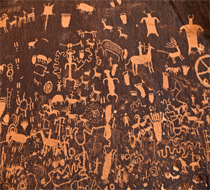
From North to South: Early Origins of the Navajo

It is not explicitly known when the Navajos migrated to the desert southwest, but various archaeological accounts have placed the tribe in the region as early as 900 A.D. Others believe they arrived in the 15th century from the Alaskan/northwestern Canadian area. Additional accounts place the migration of the Navajo tribe from the Great Plains to the east. Many anthropologists and archaeologists believe the tribe descended from the Asian region thousands of years ago, with some reports speculating a similarity between Tibetan people and the Navajos. Archaeologically, evidence to suggest their origin in these regions has been minimal at best; linguistic evidence still in use today suggests their connection to the Athabaskan tribes.
The two tribes were referred to as the Northern and Southern Athabaskan tribes, with the Southern group migrating south and becoming known today as the Navajo.In the 1500s, Spaniards took note of the assorted tribes residing in the desert southwest. In an attempt to locate the legendary Seven Cities of Cibola, Spanish explorer Francisco Vásquez de Coronado came upon the tribe and observed them in their camps. Coronado was later killed in a confrontation with the Zuni tribe while exclaiming he was immortal.With the discovery of the southwestern area by the Spaniards, European influence began to take hold of the Navajo people. In their quest to militarily colonize the southwest, the Spaniards sought to force their way of life on the Navajo, converting them to Christianity and baptizing members of the tribe. Many were killed not long after being baptized.The Spanish took a foothold in the region as they declared their intentions to takeover the southwest by any means necessary. Disease brought in from the Spaniards decimated the Navajo people, as the lack of immunity from European illnesses eventually took out several tribes and villages.